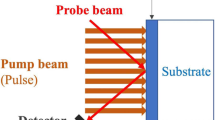Abstract
A method of direct measurement of the heat and vapor transfer properties of clothing is described when worn in situ by human subjects during rest and exercise. Additional experimental observations were used to verify that a model for predicting Fpcl is reasonably accurate. From the thermal efficiency factor (Fcl), derived from\(\bar T\) s and Tcl measurements, an effective value for Iclo can be determined and thus vapor permeation efficiency (Fpcl) can be predicted. A single coefficient (ψ) that characterizes the boundary environment over the skin surface is the ratio (hFcl)/(heFpcl) and is determined for any environment in terms of directly observed Fcl factor or clo value and relative air movement concerned. Ultimately,ψ-factor may be used as a key biometeorological parameter to describe any heat balance condition graphically on a psychrometric chart. Its usefulness is also evident in prediction of the probable combination of operative temperature and humidity necessary for thermal acceptable zones, the limits for evaporative regulation, and the zone in which some degree of thermal regulatory failure can be expected.
Similar content being viewed by others
References
ASHRAE Standard 55–74. (1974): Thermal Environmental Conditions for Human Occupancy. Amer. Soc. Heating, Refrigerating and Air Conditioning Engineers, Inc., New York.
BREBNER, D. F., KERSLAKE, D. McK. and WADDEL, J. L. (1956): The diffusion of water vapor through human skin. J. Physiol. (Lond.), 132: 225–231.
BRIDGER, A. A. and HELFAND, L. A. (1968): Mortality from heat during July 1966 in Illinois. Int. J. Biometeor., 12: 51–70.
BURTON, A. C. and EDHOLM, O. G. (1969): Man in a Cold Environment. (facsimile of 1955 Edition), Hafner, New York.
GAGGE, A. P., STOLWIJK, J. A. J. and NISHI, Y. (1969): The prediction of thermal comfort when thermal equilibrium is maintained by sweating. ASHRAE Trans., 75: 108–125.
GAGGE, A. P., WINSLOW, C-E. A. and HERRINGTON, L. P. (1938): The influence of clothing on the physiological reaction of the human body to varying environmental temperatures. Amer. J. Physiol., 124: 30–50.
GONZALEZ, R. R. and GAGGE, A. P. (1973): Magnitude estimates of thermal discomfort during transients of humidity and operative temperature and their relation to the new ASHRAE Effective Temperature (ET*). ASHRAE Trans., 79: 88–96.
Hardy, J. D. (1970): Thermal comfort and health. In: Human Factors. ASHRAE Bull. SF-70-3, New York.
MACPHERSON, R. K. — 1960): Physiological Responses to Hot Environment. Medical Research Council, Special Research Report Series # 298, Her Majesty's Stationary Office, London, England.
NIELSEN, M. and PEDERSEN, L. (1952): Studies on the heat loss by radiation and convection from the clothed human body. Acta physiol. scand., 27: 272–294.
NISHI, Y. and GAGGE, A. P. (1970a): Moisture permeation of clothing — A factor governing thermal equilibrium and comfort. ASHRAE Trans., 76(I): 137–145.
NISHI, Y. and GAGGE, A. P. (1970b): Direct evaluation of convective heat transfer coefficient by naphthalene sublimation. J. appl. Physiol., 29: 830–838.
NISHI, Y. and GAGGE, A. P. (1974): A psychrometric chart for graphical prediction of comfort and heat tolerance. ASHRAE Trans., 80 (II): 115–130.
NISHI, Y., GONZALEZ, R. R. and GAGGE, A. P. (1975): Direct measurement of clothing heat transfer properties during sensible and insensible heat exchange with thermal environment. ASHRAE Trans., 81 (II): 183–199.
Author information
Authors and Affiliations
Rights and permissions
About this article
Cite this article
Nishi, Y., Gonzalez, R.R. & Gagge, A.P. Clothing insulation as a biometeorological parameter during rest and exercise. Int J Biometeorol 22, 177–189 (1978). https://doi.org/10.1007/BF01555396
Issue Date:
DOI: https://doi.org/10.1007/BF01555396




